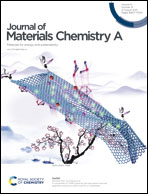Unveiling the crystalline packing of Y6 in thin films by thermally induced “backbone-on” orientation†
Abstract
Researchers are endeavoring to decode the fundamental reasons for the non-fullerene acceptor, Y6, to deliver high-performance in organic solar cells. In this work, we tackle this problem from the molecular packing point of view. By gradually increasing the thermal annealing temperature of Y6, its backbone order in thin films is significantly enhanced and eventually reoriented to the “backbone-on” orientation with the backbone plane standing on the substrate. It displays well-defined Bragg peaks in two-dimensional grazing-incidence wide-angle X-ray scattering patterns for a clear crystal indexing. The 250 °C annealed pure Y6 and binary PM6:Y6 films exhibit square and rectangular diffraction patterns, respectively. It is suggested that both are polymorphs of two-dimensional Y6 packing in its backbone plane, which resulted from its “L” shaped core-group and the biaxial backbone order through the end-group π–π stacking. Interestingly, the square lattice can be restored in the blend PM6:Y6 film by adding a small amount of IDIC. However, on the other hand, a larger portion of IDIC in the ternary blend hinders the long-range crystalline packing of Y6 and correlatedly deteriorates the device performance. This work provides an in-depth understanding of the molecular packing mechanism of Y6 in thin films for the future rational design of high-performance organic photovoltaic molecules with advantageous crystalline packing motifs.



 Please wait while we load your content...
Please wait while we load your content...